Chouteau Needs To Go On A Diet
Chouteau is too fat! Not the late Auguste Chouteau — I’m talking about the avenue named after St. Louis’ founder. Chouteau Ave has four travel lanes plus generous parking lanes, it’s too wide. I couldn’t find the curb-to-curb width but the public right-of-way (PROW) is a massive 80 feet, encompassing the road and adjacent sidewalks.
Recent road diet projects on Grand and Manchester had the number of travel lanes reduced from four to two. I don’t think that’s necessary or even a good idea on Chouteau. It’s not lined with shops, although some do still exist in places. No need to make Chouteau into a low volume shopping street but there is no reason it’s can’t accommodate the current volume of vehicular traffic AND be less hostile to pedestrians. This takes a corridor study.
Chouteau Ave extends east to the river and west until it becomes Manchester as it crosses Vandeventer, 3.4 miles long. The far east end isn’t as wide and is located in what will become Chouteau’s Landing. A corridor study should focus on the 3 mile stretch from S. 4th on the east to Vandeventer Ave on the west. The issues are similar end to end but I’ll use examples for the 6/10th of a mile section between Truman Parkway/18th and Jefferson Ave.
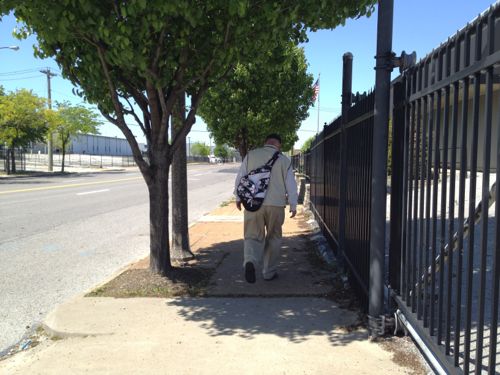
Chouteau is marked as 35mph, but given the generous widths traffic goes considerably faster.
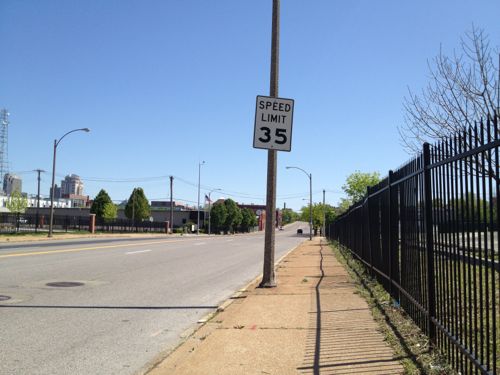
Unlike Gravois and other roads, the right side of the outside lane isn’t marked to separate it from the parking lane. Visually this tells drivers the right lane is more than 20 feet wide compared to the 8-10 feet sufficient for a 35mph road.
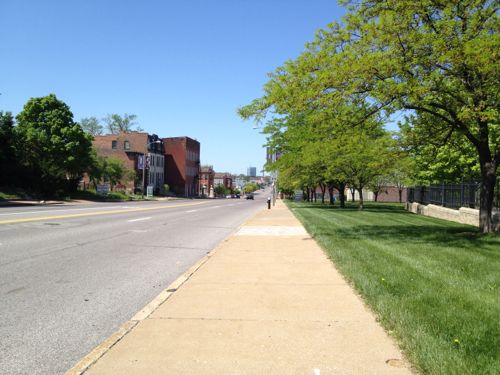
Only in a few areas does anyone park in the parking lane. , most of the time it’s vacant. Key to calming the traffic speeds is to visually reduce the perceived width of the road. This is accomplished by striping the outside lane and blub outs from the curb so the parking lane isn’t viewed as another travel lane.
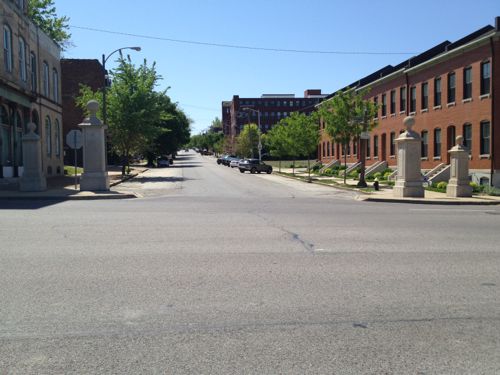
The bulb outs at Mississippi Ave had nothing to do with calming the speeding traffic but providing room for pedestrians to get around the decorative markers. Still, the push out into Chouteau is helpful but one little spot on one side only isn’t enough. Traffic has a clear shot between Truman Parkway and Jefferson, more than a half mile without a signal, stop sign or even a crosswalk. That’s right, if you live on Mississippi Ave in Lafayette Square the only two safe places to cross Chouteau Ave is Jefferson Ave or Truman Parkway.
If I wanted to have lunch at Eleven-Eleven Mississippi I’d get off the bus at the stop were I took the above picture, cross and head up the street right? Wrong. Even the able-bodied risk getting hit by a car trying to cross such a wide street with fast traffic. For me, using a power chair, I’d have to go 2/10th of mile back to Truman Parkway to cross then 2/10th of a mile back to Mississippi Ave. Realistically I’d get off the bus closer to Truman but you get the point — I wouldn’t cross here because it’s too risky. In fact — I couldn’t cross the street because there aren’t any curb cuts to make it possible.
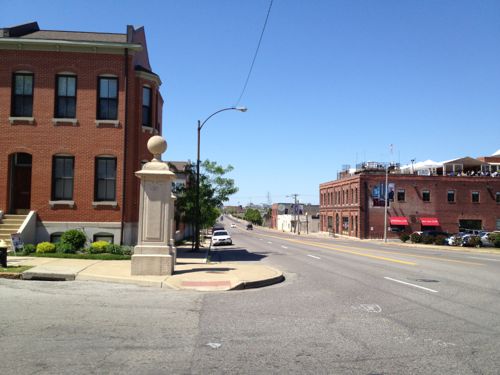
The bulb outs at Mississippi Ave have curb ramps to make it possible to continue parallel with Chouteau Ave. A corridor study of the 3 mile length of Chouteau Ave would identify key points where crosswalks are needed. Those not at intersections, like Mississippi Ave, would have a yellow caution light flashing overhead. In the 6/10th of mile between Truman Parkway and Jefferson Ave I’d suggest two pedestrian crossing points: Mississippi Ave and 22nd Street, this would equally space them 2/10th of a mile apart. Too far apart for a commercial district but adequate for this area.
This came to me recently when I attended an event at the new Sheet Metal Workers hall at Jefferson. Despite all the money spent the sidewalk wasn’t replaced.
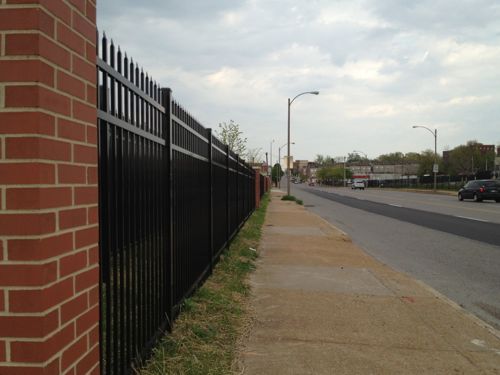
I asked Ald Kacie Starr Triplet about this at the event and she said the city will replace the sidewalk when funds are available. The sidewalk does need replacing but we should do so much more. I wouldn’t eliminate the parking lane but use bulbs to create end caps for parking and bus stop areas.
– Steve Patterson
There are ways to do road diets that needn’t cost a fortune. Striping, planter boxes, dedicated rapid transit bus lanes are all low cost options. We could improve the built environment very quickly and show a preference for neighborhood quality of life and bike/pedestrian activity in the city.
In addition to Chouteau, Jefferson, Gravois, Natural Bridge, Broadway, Page, Dr. Martin Luther King, Delmar, KIngshighway, Hampton, and Chippewa should all be studied for such lifestyle changes.
St. Louis city needs to attract people based on its quality of life/lifestyle choices. The built environment is a major piece of that choice.
While I agree that Chouteau is wide along this stretch, I don’t see a road diet as a high priority here, given the actual, bordering land uses. While there are a few restaurants, more than half of the street frontage is occupied by parking lots, many fenced, and industrial uses. There are other streets in St. Louis (as Rick noted) with more-intensive, pedestrian-attracting, land uses that deserve investments, given our finite resources. What it boils down to is do we create a better street here, and hope for pedestrian-friendly new construction? Or, do we take existing streets, that already have a significant number of urban storefronts, and make them better, as has happened along Manchester in the Grove? You give us six photos and only one shows any pedestrian activity, at all. “Build it and they will come” may work in the movies (and Steve land?), but I’m a pragmatist – spend the money on Gravois or Jefferson and you’ll see a much bigger return on investment.
I was visiting STL four or so years ago, and we ate lunch on Washington Avenue in the loft district. As we were driving east on Washington, we noticed damage caused by a vehicle to an outdoor seating area at the corner of (approx.) 19th/Washington, NW corner. The restaurant had bumped-out the sidewalk using concrete curbs AND round concrete planters filled with 6′ tall trees, decorative steel fencing, shrubbery, etc. The entire bumped out area was filled with tables and chairs, AND (if I recall) some sort of overhead canopy, or at least individual umbrella tables. Clearly, an attempt to adequately “mark” the area had been made. Even with all the efforts to clearly establish the bumped-out area as an outdoor seating area, some motorist obviously failed to recognize all the indicators and trashed the outdoor dining area. The curbed bump-out had been provided to reduce Washington Avenue at that point from approx. 2 driving lanes traveling east to west, to one driving lane. In retrospect, it obviously appears to have been a failed attempt to create a safe dining environment, and so I wonder if any licensed civil engineer/architect should consider “striping” and planter boxes only as a viable option for reducing street width. And/or I wonder about reducing street widty for outdoor dining without benefit of at least 2 streets of prior reduction.
Chouteau does not actually become Manchester; Manchester splits off from Chouteau while Chouteau continues as a side, residential street in the FPSE neighborhood where it extends to Arco, just East of Kingshighway.
You’re right! It slipped my mind, I think of that part like I do the part east of 4th.
east 4th? not familiar, is that like east Grand?
How about we take take 1/2 the street and make a bike “highway” to connect the Arch Grounds to Forest Park? Chouteau runs all the way from the river wall to the new bridge over 40 that runs you right onto Clayton Ave and into the park. I don’t mean a multi million dollar greenway here, just using cement dividers to block off 1/2 the road for bikers and pedestrians. If people biking in Forest Park knew there was way to get down to the Arch without dealing with cars they would use it. I know GRG has a plan for this at some point in the next 25 years but it would be great to do something now.
This is a great idea.
Agreed. You wouldn’t even need half the road. Eliminating the parking lane on the north side, plus narrowing the other 4 lanes+parking by a few percent, would be sufficient for a two-lane bike path. Pedestrians could stay on the sidewalks.
You could solicit volunteers from the community to paint the cement dividers however they want – creating an attraction rather than an eyesore.
. . . . or you could just wait for the gang bangers, taggers and graffiti vandals to do their thing . . . .
I don’t see any graffiti on this stretch of road right now. Even if there were, it would be less noticeable on an already painted surface than on blank stone/concrete.
An interesting statistic in this article is that bike commuters make up less than 1% of all daily commuters here (compared to 1.3% in Chicago and 2.2% in Denver), while public transit is used by 11% of commuters here. Perhaps a better option would be to make these “extra” lanes into bus-only lanes, and improve Metro’s bus service into downtown (and build on something that is attracting more than 10 times as many commuters) . . . . http://www.governing.com/blogs/by-the-numbers/bicycle-commuter-data-for-american-cities.html
throwing your bike on the link is a good way. a bunch of concrete barriers gum up the works and give the city that Baghdad feel that some of us would like to avoid. A good bike right through the central corridor would be a very good idea. we have the train yard running through downtown, midtown and cwe. perhaps creative use of some of that space would be an option.
Yeah they could do this with temporary concrete barriers. Would be cheap.
The train yard is very human-hostile and is just a few hundred meters closer to the main corridor that is Chouteau. Not much in bike terms.
Some great ideas, I know more people ride bikes in winter in Finland than the in the summer here in St. Louis. It is because the City of Helsinki, and the whole of Finland for that matter, is designed for bicycles. Paths, routes, destinations and accommodations for the bicycle abound.
This comes back to an overall idea of what is to be accomplished. Whether Chouteau is four lanes or two depends on a lot of factors, a big one being the status of transit. Maybe the extra lanes become Bus Rapid transit or dedicated bus lanes.
Much of Chouteau has seen devastation of its original scale from only a few decades ago. This is happening in other parts of the city. Another industrial style building is going up on Delmar, just East of Euclid. The building itself is framed out and looks attractive enough at this point, but it is pretty clear there will be front loaded parking. Not to mention it is near a major commercial district (CWE).
St. Louis has to decide what to do with it streets, with its environment, with its future. You have to have some semblance of structure and idea what you are trying to accomplish with this city. The bullshit than anything goes for any project is a ridiculous notion.
If you write a novel would you just write any old thing every day? Just kind of wander through the novel aimlessly? That is how city planning is done in St. Louis.
Getting back to the bicycles, success requires a city that not only builds paths, but also one that is dense and decentralized with an emphasis for walking.
I just don’t see how intelligent decisions could be made for a major street like Chouteau without some commitments on exactly how it is you are trying to build all of St. Louis. Everything is closely connected, that is the beauty of the City, or should be.
Please explain how a city can be both “dense and decentralized”. Like most American cities, St. Louis has been moving from dense to decentralized for decades.
I agree that how people transport themselves (walking, biking, driving) informs how urban areas are built out. It would appear that much of St. Louis was built “with an emphasis for walking”, yet most people are now choosing to drive. It seems to be less of an infrastructure problem and more of a perception / reality problem – driving a car costs more and can be a hassle in many ways, yet people like the fact that it goes where they want, when they want, usually in air-conditioned comfort, and with a small group of passengers of their own choosing, or none at all.
We can’t change our weather, we continue to invest in new highways and “free parking” and we have a transit system that inevitably takes three times longer than driving, if it even goes where we want to go. Add in relatively-low land values and few physical or political barriers to sprawl and what you see is what you get. How do we change this dynamic short of imposing some sort of draconian central planning and imposing punitive taxes on private vehicle ownership?
its pretty simple, the built environment is dense, the population is decentralized, get it?
Decentralized commercial for instance, neighborhood stores rather than massive central malls. The original city was spread out evenly within its borders. You didn’t have to go across town for every need. Local parks, local schools should be maintained and increased. Old St. Louis did both density and decentralization well.
A coherent city plan that made sense would attract investment. In other words everyone would benefit if the city had some clear goals. I have pointed out the Unitary Development Plan of the City of London (now evolved into the Local Development Plan) where London used strategic goals as a framework for planning.
Thus in St. Louis a strategic goal might be to maintain walkable environments. Thus projects are encouraged to maintain walkable street fronts and strive to put parking around back or built in some manner than does not interfere with the pedestrian environment. (Naturally some areas and streets would have more of a priority in implementing this).
St. Louis City has all of the legislative tools, not only that, the City offers many financial incentives. These should be used like the historic tax credits they not be available to those who don’t follow guidelines.
Take Haussmann and the remaking of Paris. Buildings built along the new boulevards had to meet stringent requirements. The result is a beautiful city. Other cities manage their affairs without becoming draconian. St. Louis is far, far from draconian.
People chose massive central shopping centers (for example: Walmart, Schnucks) because they have better prices, selection, and hours than neighborhood stores. And they don’t drive all the way across town to those stores. They drive 1-2 miles to the supermarker and 2-4 miles to the big box store. Still it is too far for most people to walk.
Sure, St Louis could give massive tax incentives for your type of building, but is the benefit worth the massive cost? Paris is not a good example. It is so expensive that only the rich can live there, among other reasons because of the stringent restrictions on building height.
So Schnucks needs a new business model, one that disperses butchers, bakers etc in buildings throughout the neighborhoods. City government does not make a case for transit or for the neighborhoods.
The highest human value is not to buy cheap shit from China. There are countries in Europe that restrict box stores, pointing them into selected, appropriate locations. In St. Louis that refinement doesn’t matter. The main difference is Wal-Marts, Schnucks etc are exclusively auto orientated. If we are to conquer oil addictions, then urban planning should start with the walking city and then move from that point to achieve a movement system in balance that includes autos.
Paris is a good example. The example is that cities can control their destiny, unlike St. Louis, which has been in continual decline for 60 years now. The fact Paris is expensive only reinforces the point that good city design creates value and success.
Who are you to tell people what they should like and what is good for them?
Let’s see, auto centric development has been shoved down the throats of citizens for decades, The St. Louis U episode at Grand and Chouteau being being the latest episode.
Shunucks, WalMart and the other big chains are subsidized with how current urban planning is conducted. All to the exclusion of pedestrians, bicycles, and transit in general.
And I am the one trying to tell everyone what to do?. Please: that is laughable. Look at reality.
So I introduce a few concepts and examples that include the rest of civilization in city planning and all of sudden I am attacked personally?
Your approach only further enables the idiocy of current city planning.
It is not good company you are in.
“Decentralized commercial” assumes a large amount of interchangability and uniformity. Examples that fit this definition are McDonalds, Starbucks and Walgreens – most customers aren’t interested in a specific one, just the nearest one. In contrast, most local businesses and many national chains strive to be unique – for example, there are distinct differences between our various local microbreweries, and they each draw customers from well beyond their respective neighborhoods. It’s similar on the employment side – most of us don’t want to be interchangeable cogs in some faceless corporation, we want to work someplace where we feel like we’re making a meaningful contribution, and for many of us, that means commuting outside the neighborhood we live in. How do we reconcile the desire to be neighborhood centered with the reality that we have many, many more choices, many times better ones, beyond our own ‘hoods?
The basic unit is walking in city movement systems. Locating services in local areas of the city is pretty well standard urban planning around the world back to classical times. How in the hell did you come to equate chains with a decentralized city? And then say it means that it won’t allow people to go outside of the neighborhood they live in is hilarious. Study the reality in decentralized and dense Old St. Louis, then you would have a better idea how cities should work.
This area is mostly industrial. Pedestrians aren’t going to walk this length…they will drive it or take the bus. Personally I hate the concrete bumpers. And please, you want Beruit, go to East St. Louis, this is not even close to it. It is however, just………………..vacant. I was disappointed when Metro Lighting (not metro bus) built their new office/warehouse….nothing like a 40 foot tall brick wall going the length of the block. And a Rapid transit lane? for what 2 miles? It would be over before you even finished accelerating. And while the speed may be a bit fast, most times I’ve travelled it, it’s been about 35 or so. I’ve never seen someone going 50, 60 or higher.
Is it wasted space? Yes. Is there potential? Yes. But there are other areas that need it first.
I understand not liking the concrete barriers, and I agree that we should utilize the train corridor at some point, but that is one of those long long term projects. This is something that could be done in a few weeks and the barriers could be painted yellow or green just for looks. I also admit this corridor is not much of an attraction in itself, I am thinking of it as a way of connecting 2 points, the arch and the FP. Plus this would help build the bike community and get bikes off other streets between FP and Downtown. I personally would go a few blocks out of the way to jump on a bikeway knowing it would keep cars away from me and my 3 year old co-pilot.
. . . . or, instead of waiting, you could try using existing, parallel streets that have a lot less traffic – starting at Kingshighway, I’d head east on Laclede, thru SLU’s campus, all the way to Compton, then head north to Locust, turn right onto Locust, to 13th, then jog south one block to Olive, then follow Olive into downtown.
Try remembering all those turns if you’re biking the route for the first time. And be no less vigilant than on a major road, because while cars are somewhat less frequent, any one of them could still kill you.
Anyway, why should the bikes have to take the parallel side streets? If there really is traffic in Chouteau then let the extra cars take the side streets!
The two big problems with a parallel off-street bike path next to a busy street (versus sharing the street with cars on less-busy parallel streets) are second-class maintenance and a false sense of security. Most city streets are only swept along the curb lines, since vehicles and rain tend to push debris to the curb. Unless the city is willing to take on more lane miles, the odds are the “new” bike lanes won’t be swept very often, leaving cyclists to deal with more flat tires. A much bigger issue would be drivers turning in front of cyclists at cross streets, curb cuts and driveways. The most likely scenario will be having “stop” or “yield” signs for cyclists at each intersection, which certainly won’t create a high-speed bikeway. Personally, I’d much rather share a lane with a few vehicles than to try and guess which of the many is going to turn in front of or into me and “not see me”.
I wonder if there’s a way to build a coalition of aldermen to try this out as a pilot project with the street department to make this happen? The first step would be to get neighbors on board. Lots of neighbors would oppose it. Some businesses would oppose it. There might be resistance from police and fire. Given all the headwinds, this is often the reason why elected officials don’t wade into these sorts of issues.
On the other hand, one exciting thing about a project like this though is the way it gets people out of the box of thinking only about their own wards and neighborhoods. If it takes 4 or 5 neighborhoods and 3 or 4 aldermen to make one city-wide road diet improvement project happen, one that reshapes neighborhood quality of life for the better, who wouldn’t want to be part of such an exciting, innovative, creative, project?
Sure would be nice to see issues like these lead the discourse in our city rather than the fight over firefighter pensions.
I agree Chouteau could be improved and a better pedestrian area would be nice for the nearby neighborhoods and SLU. I even like the bike highway idea.
I use Chouteau frequently as a runner and driver; it’s my go-to non-highway east/west route. I have got to say Chouteau has never bothered me. Leave Chouteau alone for now. It has great potential and I could envision some lovely future improvements. But until Jefferson, Broadwy and Tucker get fixed there is no sense doing anything to Chouteau.
7th/Broadway from the ballpark to the brewery is the most miserable pedestrian experience in St. Louis. And unlike Chouteau, these roads have a mix of vehicle and pedestrian activity. Broken sidewalks, uneven pavement, too close to traffic, no shade, trash, loud, trucks, no ramps, etc.
I am excited to see some work with going on at Broaway. $1 improvement on Broadway or Tucker or Jefferson would go much further improving the walkability of the near southside than anything spent on Chouteau.
amen amen amen, please tell me you work for the city
I still say do a corridor study and figure out where we want to go. Then as we make improvements, like new concrete in front of the Sheet Metal union hall, the new work can incrementally work toward the vision.
The corridor study has been done…by the Great Rivers Greenway. There is a long-term plan to consolidate the rail lines and turn the unused lines into a park/bike path stretching from the river out to SLU. At least there was when I was on the Citizen Advisory Council back at the turn of the century.
Hpw does something like this go from the pages of a blog to the streets of St. Louis? A meeting with Todd Waeltermann would be a good next step. WIth a proposal in hand.
Not sure Rick. And Moe I know GRG plans to do a greenway on the extra railway lines heading west from DT to Midtown, but I have not seen or heard any news on this project in 5+ years. There are certainly a lot of potential maintenance issues with the bike highway, and cars making right turns across the path is a HUGE problem too. If the alderman were on board, maybe we could have a test period with ugly cement dividers like they did with the south grand street project. If bikers used it and it went well then the city could come back and make it better looking and more permanent.
The City of STL already has a road diet plan for Chouteau Avenue that is actually pretty decent. Implementation is the problem.